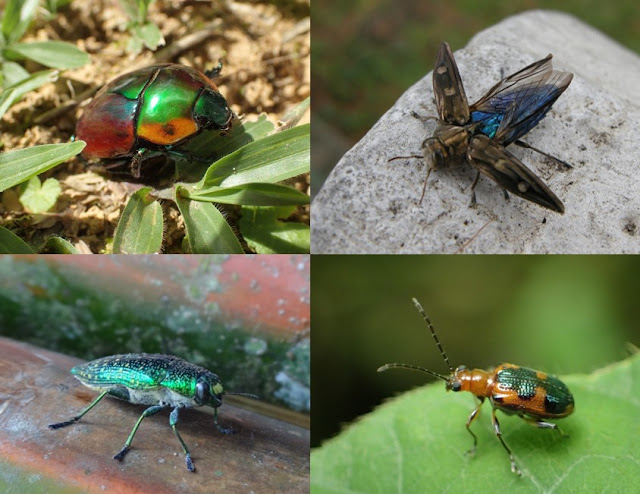This week, Dr Amy Deacon, Lecturer in the Department of Life Sciences at The University of the West Indies, St Augustine and Secretary of the Trinidad and Tobago Field Naturalists’ Club continues her series on the biodiversity of the Main Ridge Reserve (MRR). Today, she teams up with UWI Entomologist Raj Mahabir to introduce us to the beetles of the MRR.
When you think about the biodiversity of the main Ridge Forest Reserve, which creature springs to mind? The sabrewing hummingbird? The blue-backed manakin? The agouti? It is probably safe to bet that you are not imagining a dung beetle. Today, we are here to convince you that these smaller inhabitants of the MRR are just as important and interesting as the more familiar animals associated with Tobago’s forests. Almost a third of all insects are beetles – more than 300,000 species worldwide. They are distinguished by their hard outer wings, which protect the delicate flight wings underneath. At least 700 species are found in Tobago alone, and they play many essential roles within the ecosystem, from pollinating plants to eating pests.
 |
| Beetles come in many shapes, sizes and colours, but each has a hard pair
of outer wings protecting their delicate flight wings underneath (see
top right). Photos: Amy Deacon |
Within the MRR, the biggest and perhaps most impressive beetle is the longhorn. They are easily recognised by their extremely long antennae, which are often much longer than their bodies; these sensory organs are used to navigate their environment, helping them to detect food and possibly members of the opposite sex. The largest Tobagonian species is the aptly named giant longhorn beetle, which can reach up to 12cm in body length. While the adult giant longhorns fly around the forest canopy in search of sap, fruit and nectar, they choose to lay their eggs in rotten logs nearer the forest floor. Here, the ever-fatter grubs spend the first part of their lives feeding on decaying wood before pupating and emerging as majestic adult beetles. Some species of adult longhorns also feed on wood, and others act as pollinators for canopy flowers, providing an important function within the forest ecosystem.
 |
| A giant longhorn beetle, with hand and phone for scale. Photo: Amy Deacon |
In contrast, a beetle that spends the entirety of its life on the forest floor is the dung beetle. As their name suggests, these round little beetles spend their adult lives in search of mammal excrement. In the MRR, this will most often be mouse, agouti and tattoo dung, which they sniff out. While some species dig inside the pile of poo to feed and lay their eggs, others carefully make a neat ball, which they then push along the forest floor using their back legs. They can roll the dung over several metres until they find a suitable place to feast or to park the ball and lay their eggs; strenuous work for a small beetle, especially as the ball is often larger than they are! Eggs are laid inside the ball, and hatched young then feed on the dung from the inside out, until ready to search for their own food. Dung beetles are vital to the natural cycles of the forest as they speed up the decomposition process, returning nutrients to the soil.
 |
There are several species of dung beetle found in the MRR. Photo: Raj Mahabir]
|
Another of the beetles we are lucky enough to enjoy in the MRR, as well as in our gardens and parks, is the lightning bug or candlefly. Many people don’t realise that this nocturnal glowing creature is neither a bug nor a fly, but in fact a beetle. The misunderstanding is forgivable given that we generally encounter the pulse of light, not the drab, brown insect. It’s common to see the odd one or two in suburban areas, but it is a truly magical experience to find yourself on a dark night surrounded by natural fairy lights flickering on and off in the canopy.
 |
| A lightning bug or candlefly –also known as a firefly. A chemical
reaction in its abdomen allows it to send light signals to other
fireflies. Photo: Amy Deacon |
The light is created by a chemical reaction in special organs in the beetle’s abdomen, and the flashes we see in the dark are in fact part of a conversation between courting males and females. The MRR is home to several different species of lightning bug, each with a unique sequence of flashes.
Interestingly, males emit their light signals while flying, while females glow from the ground. Their light can also attract predators, but their bitter taste deters those who fancy a luminous meal. As you might imagine for a creature that communicates by means of light, these beetles are sensitive to light pollution as it interferes with their signalling, therefore the MRR is a welcome refuge for them away from human settlements and electric lights.
It was only possible to introduce three out of the hundreds of types of beetles on Tobago within this short article, but these should give at least some insight into the amazing insect biodiversity that is present in the MRR. Next time you wander through the forest admiring birds and flowers, remember the world of activity that is going on above your heads and below your feet– busily maintaining the natural balance of the ecosystem!






